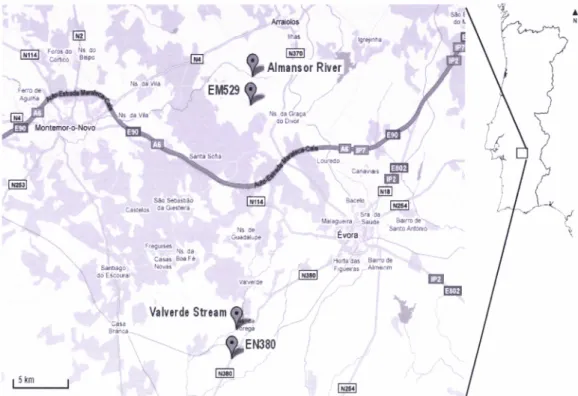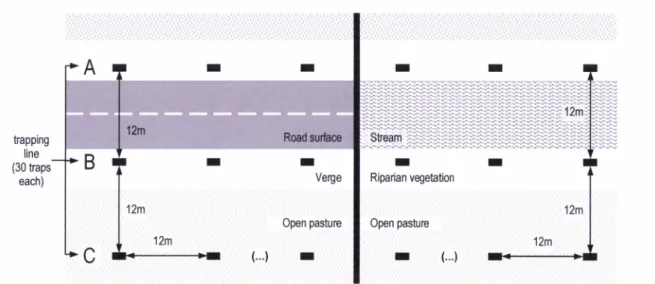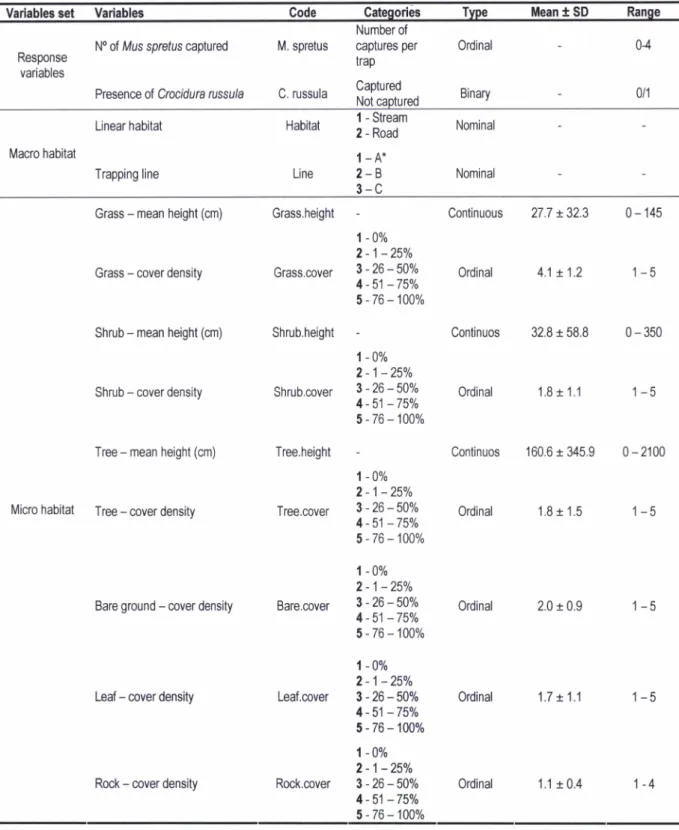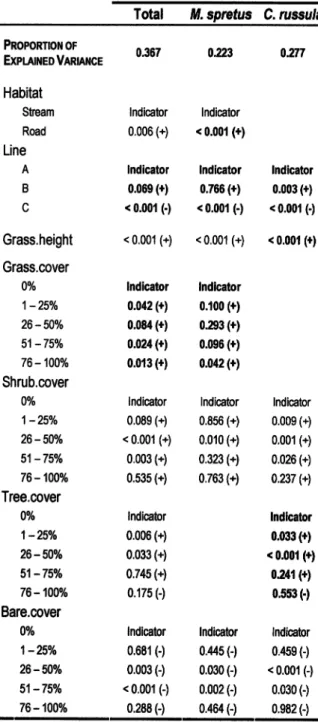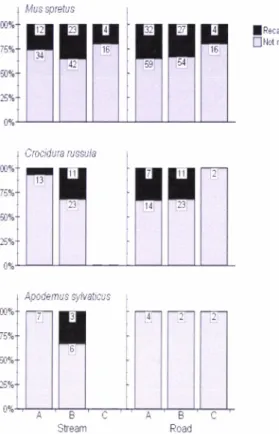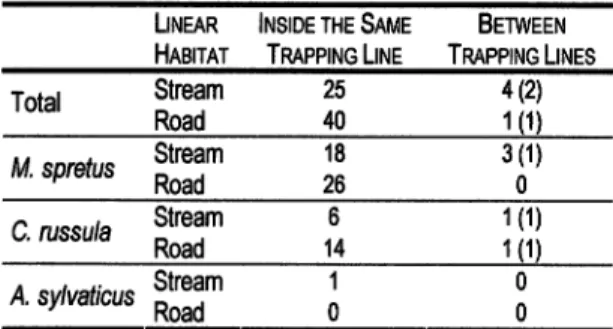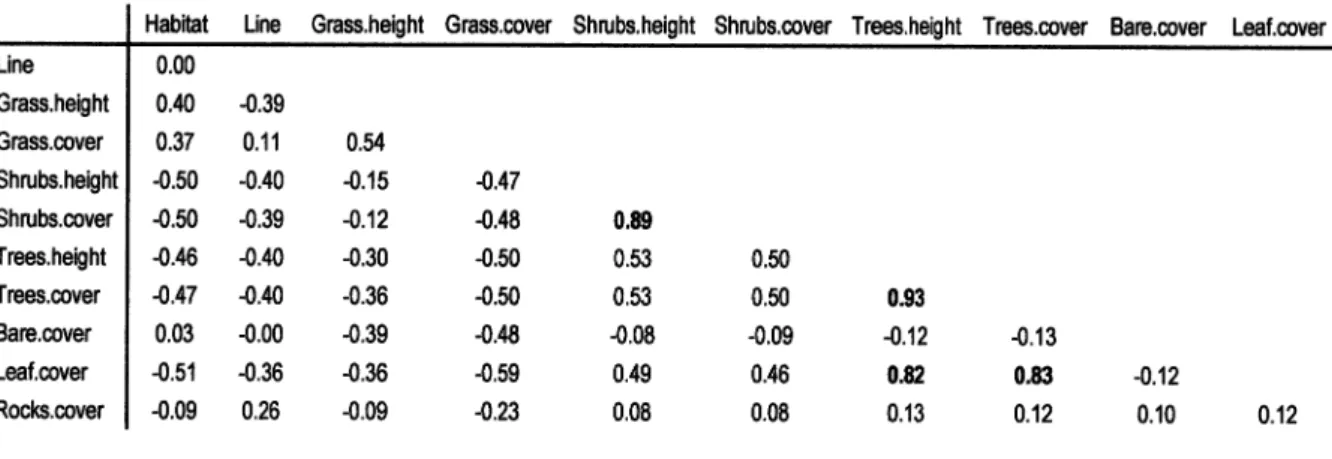,'
UE
172
UxTvERSTDADE
DE
ÉvoRA
À^estrodo
ern
Biologio
do
ConservoÇÕo
o
Pa?el
dâs
Estruturas
Lineares,
Artificiâis
e
Nat
urais,
corno
Locais
de
Re{agi
o
de
Mic
rornarnÍferos
DissertoçÕo
reolizodo
por:
HTLENA
ISngrT
SngINo
MnnQUES
Orientoçõo:
PnOr.
DR.
ANTONIO
MIRA
20
ÉvoRA,
a' aI
7r0
UxMERsTDADE DE
ÉvoRA
/Vestrodo
em
Biologio
do
ConservoÇÕo
Pa?el
das
Est
rutuFâs
LÍnea
res,
Art
ificÍais
e
Nâtu
raí
s, co
rno
LocaÍs
de
RefagÍ
o
de
Míc
rorn
anferos
LívÍ
ng
ort
the
ve
rge
:
are
roads
a
rnore
suÍtable
re{uqe
fu
srnall
rnanrnals
th
an strearnsl
a t
Dissertoçõo req lizodo
,o1,72'9
HTLENA
Isngrl
SngINo
MInQUES
Orientoçõo:
Umvensroloe oe
Évonn
Mesrmoo
EMBtolocrA
DACousenvlçÃo
0
Papel
das
Estruturas Lineares, Artificiais
e
Naturais, como
Locais de Refúgio de Micromamíferos
Helena Maquesa e An6nio Miraa
r UBC - Unidade de Biologla da ConsêÍvaÉo, DepaÍhmenb G Biobgia, Untuenidade de Ércna, Portryal
PALAVRAS.CHAVE Habitab Lineares MicromamÍferos Bermas de esúada Ribeiras Mussprcftrc Oocidunrussula Enderqsde+mail: lenasmarques@gmail.com (H, Marques), amira@uevora.pt (A. Mira).
RESUMO
Avaliámos a importância das bermas das esfradas oomo áreas de refiigio
para pEuenos mamíferos, em paisagens Meditenânicas intensivamenb pastoreadas,
e
comparámos esta posslvel função das estradasomo
refugio com o papelfundamental das galerias fipíoolas como reserua6riosde diversidade biológica. Para esse efeib, funam rcalizadas capturas de micromamiferos em dois segmentos de estada e em duas dbeiras da região
de Évora. Foram capturados 457 individuos de cinm espécies diferenbs. Mus spreÍus foi a espécie mais capturada, seguida de Gocidun russuía e Apodemus sylvaticus.M. spraÍus apresentou uma maior abundância nas
bermas
de
eshadado
que na
vegetação dpicola, enquanbque
a abundância de C. russula eA.
sylvaticus era semelhanb para ambos oshabitab.
O
número de capturas dasfês
espécies foi bastanb supedor denúo dos habitab lineares do que na matriz cinarndanb. Os indivíduos de M. sprcÍus eram maiores nas dbeiras, mas significativamenb menores6ra
dos habitab lineares,
e
os indivíduosde
C. russula apresentavam uma melhor oondi@o corporal nas bennas das esúadas. Tanb as esúadas mmoas ribeiras exerceram um
forb
efeitode
baneira aos movimenbs dos micromamÍbros. Conduímos então que as bermas das estadas actuamcomo habitat
de
refiigio
em
áreas
sutsÓptimasdas
paisagens Meditenânicas.Uruvensrvor
ÉvonnMmrrn
N
CoNSERvATpN
BloLocY
Living
on
the verge: are
roads
a
more
suitable refuge
for
small mammals than streams?
Helena Malquesa and António Mira.
" UBG - Unidade de Bblogh da Consoruafio, Deparbrnnb de Bio@ia, Univensirlade de Évora, Portqal
KEYWORDS ABSTRACT Linear Habitats Smallmammals Road Verges SmallStreams Mus spreÍus Crociduru russula E-malladdrcssee: lenasmarques@gmail,com (H. Marques) amira@uevora,pt (A. Mira)
í.lntroduction
It is widely
acepbd
fiat
retaining natunal rcmnantconidos
of
habitat
is
a
useful
and
practicalconseryation measurc, which
can
aüenuate
fie
efiecb
of
habltat loss and ftagmentaúionon
wildliÍe(Downes
et al.
1997, Beier and Noss 1998, Bennett2003). By providing additional habitat for species liúng
in
modiftedenürcnmenb,
linear structures make adircct contdbution
b
the conservationof
biodivensity.They may substantially increase
the total
amountof
suitable
habitaúand,
in
some cases,
compdse a substantial amount of the remaining habitat availableto
wildlife, suppoiling rcsident
indiúduals
or populationsof
animals,and playing
a
key role
inmaintaining the diversity
of
wildlifeand
conünuityof
ecological pÍocesses
in
heavilyalbred
environmenbWe assessed the importance
of
road verges as refuge areasbr
small mammals,in
highly intensified grazed pasfureson
a
Meditenanean landscape, and compared road function as refuge wih üe fundamental role of ripafian galleries as reservoirs of biological diversity. For this puÍpose, a small mammal fapping study was undertaken on road verges and on small súeam sides. We sampled two road segmenb and two sfeams in the vicinityof Évora, Portugal. We captured
a
total of 457 indiüduals of five different species. Mus spreÍus was the most common species captured, followed by Crooidun russula and Apúemus sylvaticus. M. spreÍus was more abundant on road verges han on riparian süips, wtrilsthe
abundance of C. russula andA.
sylvatbus were similar in the two habitab. Captures of the ftreespecies were much higher inside boh linear habítats han on the sunounding maúix. M. speÍus werc bigger
on
sheam sites but significantly smalleroubide
he
linear habitats and C. russula had better body ondiüons on roads. Boür roads and sfeams exerteda
strong banier efiectto
small mammals' movemenb. We concludehat
roadside verges act as refuge habitat in subopümal Meditenanean landscapes.(Bennefi í990, 2003, Downes
et
al. 1997, Penault andLomolino 2000, Gelling
etd.20071.
Ripadan
areas
constififre
one
of
the
mostwidesprcad,
diverse and
dynamic natunal Íemnantconidos, and
arc
known
as
some
of
the
most productiveand
divensehabiffi
availableto
wildlife,providing important
habiht
for
many aquatic
andtenestrial
species (Naiman
and
Décamps
1997,Gomez
and Anhony
1998, Cockleand
Richadson2003). They play a significant and often essenüal role
in
the
maintenanceof
wildlife communitiesin
theadjacent upland
habiffi
(Gomez and Anthony í998,Bennett 2003). Riparian strips
arc
generally cooler,vyetbr,
more
súucfunally
complex,
and
more productive than upland arcas (Naiman and Décamps1997, Bennett 2003, Cockle
and
Richardson 2003). Their diverse composition and structurc of vegeHionand vadability
in soil
moistuÍe maycreab
importanthabitat
for the
survival and
reproductionoÍ
manyspecies
by
providing
food
and
other
essentialÍesources, like shelter (Naiman
and
Décamps 1997, Gomez andAnhony
1998, Bennett 2003). ln the caseof
small
mammals,dpadan systems
are
usually described as important habitat, and may be cdtical tothe
conservationof
these species (Gomez
and Anthony 1998, Maisonneuve and Rioux 2001, Waterset a|.2001, Cockle and Richardson 2003),
Ecologls§ have
reently
acknowledgedhat
rcadsysbms aÍê
oneof the
laryestand
most extensivefunctioning
systems
of
linear
habiffi
on
Earth(Forman
and
Alexander 1998, Bennett 2003). Thevast
network structure
of
road
systems,
theirpervasive
sprcad
throughout
many
difurentenvimnmenb, and the large area that they occupy are indicative
of
a
significanteological
effect (Bennett 2003). Therels
much concem about üre detrimenhlefhcts
of
rcad
systems, pailicularlytheir rcle
as ecological baniens, as a source of morhlity for wildlife,and as
a
souÍceof
disturôanceto
adjacent habitaband the wider landscape (sêe reviews by Forman and
Alexander 1998, Spellerüery
1998,
Trombulak andFrissel 2000, Forman et aL.2003, Coffin 2007). Small
mammals
arc
often killed
by
üaffic and may
bercluctant to crcss mads, even when the rcad is natTow and covered only by gravel (Oxley et a|.1974, Swihart and Slade
í9M,
Brcck and Kelt 2004). However,$e
extent
of
road systems andtheir
levelof
strucfuralconnectiüty suggest that therc may be advantages for specbs that are able
to
usehe
associated rcadsidehabitab
(Bennett2003). Road verges
do
proüdehabitat
fur
some
animals, particulady insects andsmall
mammals (Oxleyet
al.
1974, BellamyeÍ
al.2000, Forman
et
a1.2003, Cofrin 2007) and some mammal species have beenbund
b
use rcads asmovement conidons (Forman
and
Alexander 1998,Brcck
and Kelt 2004, Cotrn 2007).
Moreover, inlandscapes where almost
all
native vegetation hasbeen
rcmovedfor
cultivationor
pasturc,
roadsidevegetalion
sfips
may
be
especially valuable
asreservoirs
of
biologlcal
divercity
(Forman
andAlexander í998, Cofrin 2007).
Thercfurc, we wanted to assess the importance
oÍ
rcad verges
as
rcfuge arcasfor
small mammals, inhighly intensified gmzed pasfures on
a
Meditenaneanlandscape,
where litüe infomation
exisb
on
fris
subject. The grazing-induced changes
in
vegetationand in soilcompaction produce strrong
eftcb
on small mammal abundance and species dchness (EccadeÍ
d.2000, Tore
eÍd.2002,2007),
so the subsistenceof
linear habitabin
structurally simple grazed areasshould be
of
highsignificane.
Also,we
intendedb
compaÍe road function as refuge withüe
fundamenhlrole
of
riparian galledesas reseruois
oÍ
biologica! divercity.Small mammals have a major rcle in ecosysbms.
They
arc
fie
pdmaryprcy
for
many
camivorousmammals,
snakes
and
birds,
and
consume invertebrates,planb
andffieir
seeds,aftcting
plant species composition and soilbÍtility
ürrcugh selectiveheôivory and seed dispensal (Cockle and Richadson 2003, Michel
et
a1.2007,Tone
et
al. 2007, Sullivan and Sullivan 2009). The study of small mammals offiermany advantages, since
hey
are
usually abundant,widesprcad
and
rcadily
sampled
by
trapping techniques. Besides,üese
species usually rcspond to disturbancesin a
perceptibleand
measurable uay,and their
short
generationtimes allow
for
quick detectionof
environmental changes (CoffinaneÍ
aí.200í, Butet et a1.2006, Bissonette and Rosa 2009).
The main
aim of our
study wasto
evaluate, forsmallmammals:
1) The rcle of road verges as refuge in suboptimal landscapes, i.e. when the
matix
is dominabd by high intensity grazing by catüe;2)
Comparethe
importanceof
roads verges asrcfuges
with the one from
a
natunal linear habitat, riparian areas;3)
Comparc the permeabilityoÍ
roads and smallstreams to movemenb of small mammals.
For this purpose, a tapping study was undertaken
to
survey
the
diversityand
abundanceoÍ
small mammals andto
quanüfy small mammal movementboth
on
rcad
veÍges
and
small
stream
side.Specifically,
our
objectiveswere
(i) to
identity thehabitat charactedstics that favour
the
occunenceof
small mammals,
(ii)to
assess and compare üre efiect of habitat on sevenal population parameterc, includingsex natio, age, body condition of the individuals, and populaüon tumover rates, and (iii) to charactedze the
movemenb
of he
most abundant species
andquantiff
the
numberof
rcad and dver crcssings. We assumedthat
populationsin
infedor qualityhabiffi
rrrould have skewed
sex
ratios, younger individuals,poorcr body
conditionand
a
lower
proprtion
of
recapturcd animah (lower rcsidence time).
2. Methods
This study was conducbd in the
vicinis of
Évora (38o34'N, 7o54'VV), Central Alentejo region, southemPoilugal.
The
rcgion
is
included
in
the Mesomedibmanean thermotype of the Medibnaneanpluviseasonaloceanic bioclimate (Rivas-Martínez and
Aregui
1999), with dry and hot summerc and cold andE
r1'. :'r,r y'rl* EM52g ::i'úll,+ Anarolos lil'âá lg klrr.'rÉ@
Almansor Riverm
@
';:r#'J,il;t
i
Nr dâ &âçá .:r 1 '.t Montemor-oNovo@
LÍur-Àíú ,Lãrrâ,riâi GEEItu
@ iar-'elr: 6, Srà CâLtaiagr*,ra Ssu{e flarrro íe
Évora 'ània ÁntÚrxá t: i r,,Ér' i. i.,ltnê 'rltl
@
l IEE@
#fii,
valverde§trea'%t
SrffiBo
@
*
I Sknt I
@
Figure 1. Location of the 4 sampling sites.
average precipitation ranged from 2.4 mm
in
July to97.3 mm
in
February (SNIRH 20An, Specifically, themonthly
precipitationduring
the
field work
datacollection,
in
October 20A7, was 48.5mm, less thanthe average monthly precipitation of 75.0mm (SNIRH
2007)l. Topography
is
mainly plain,
with
altituderanging
from
100to
300 m.
Landscapesare
highlyfragmented, with typical Mediterranean agro-pastoral
woodlands of cork oak (Quercus suber) and holm oak
(Quercus ilex), locally known
as
montado and openareas
of
pastures, extensive culturesof
cerealsin
afallow cereal rotation basis,
and
inigated
annual crops.Four study sites were chosen, two pairs of a road
segment and
a
riparian vegetation area,to
comparesmall mammal communities between these two types
of linear habitats (Figure 1). Field data were collected
in the
last two weeks
of
October 2007,after
theseason's
first
rains
and each
pair
of
sites
wassampled simultaneously. The first pair
of
sites was a section of national road EN380 (38028'N, 8002'W), and a portion of Valverde Stream (38029'N, 8o02'W), whichwere
sampledin
the first week
of
data
collection.These two sites were distanced from each other by
approximately
2,2km
to
control
the
effect
of geographica! variation. The second pairof
sites waslocated 20km
to
northand
incorporateda
section ofthe
municipal road EM529 (38039'N, 8001'W), and asection of the Almansor River (38040'N, 8001'W). This pair of sites was sampled on the second week of field
work, being the distance between these two locations
also 2,2km. These four locations were chosen due to
their similarities and linear structures width, allowing
experimental design specifications
to
be
respected(see
furtheron).
EN380and
EM529are
two-laneasphalt roads, with no paved verges and are 7 and 6m
wide, respectively. Road verge vegetation was mostly
grass, with small portions with shrubs and/or trees.
Valverde Stream
and
AlmansorRiver are
mediumwidth riparian lines,
with
herbaceous,shrub
andarboreal layerc
constituting structured galleries of dense vegetation cover. Both stream sections weredry
during data collection, allowingthe
crossing ofsmall
mammals betweenthe two
margins.All
fourstudy sites were within
a
matrixof
open grassland,and were reeently grazed by cattle.
2.1 . Field Methods
Animals
were
captured
using
medium
sizeSherman live traps (8x9x23 cm), baited with a mixture
of
oat-flakes, sardinesand
vegetableoil,
and
rawcotton was provided for bedding. At each study site g0
traps were placed in three trapping lines sited parallel
to the road or stream (Figure 2). Two of these lines (A
and B)
were positionedon
eitherside of the
linearhabitat, in road verges or riparian vegetation, and the
third (C) was
placed furtheraway from
the
linearhabitat and within
the
pasture matrixon
one side ofthe
roador
stream.All
three lineswere 12n
apartfrom each other and consisted of 30 traps each, also
placed
at
12n
intervals.In
orderto
keepthe
samedistance
betweenthe
line traps
on
the two
rivermargins, both lines
A
and B in the
Almansor River^
trapping line (30 traps
each)
were sited at the exterior border of the riparian gallery,
while
in
Valverde Stream trapping lineA
hadto
be positioned inside the riparian gallery.Each
trapping
session
consisted
of
four consecutive nights (360 trap-nights in each site, totaltrapping effort
of
1 44A trap-nights), during which trapswere
checked
every
moming
at
sunrise.
Uponcapture, all animals were identified, measured, sexed
via examination of ano-genital distance (this was not possible
for
Crocidura russ ula, due to lack of extemalsexual features), inspected to determine reproductive
condition,
and
weighed
using
hand-held Pesola@spring scales. Each captured individual was marked
with a specific fur clip identifying trapping line and day
of capture or recapture, and released at capture point immediately after data collection.
Microhabitat parameterc describing
vegetationstructurc
were
measured
in
0.5m
radius
circlescentred
at
each trap
location. Substratetype
wasidentified
(bare
ground,leaf litter
or
rocks), meanheight
of
grass, shrub
and tree
were
calculated(through
the
measurementof
each
stratumat
twopoints,
one
at
entranceof
each trap, and
anotherchosen randomly within the 0.5m radius circle), and its
cover density were estímated (in 5 classes, see Table
1),
2,2. Data Analysis
Abundance in different habitats
Numberc
of
captured animalswere used
as
a measure for comparing population size between linearhabitat types (stream
vs.
road) and trapping lines (Avs. B. vs.
C). Contingency tables were usedfor
thecomparison
of
species composition,and
the
Log-likelihood
ratio,
or
G-testwas
applied(Zar
1996).I
Riparian vEetation
Figure 2. Schematic of Sherman live-traps positions along linear habitats in road and stream sites.
Differences
in
abundanceof
small
mammals
instreams
and
roadsand on the three
trapping lineswere
analysedwith
chi-square goodness-of-fit test,and
a2x
3 contingency table (stream vs. road x A vs. B vs. C) was used to check if the proportion of animalsin
eachof
the trapping lines was similarfor
the two habitats (Zar 1996).Small mammal response to habitat characteristics
Generalized
Linear Model (GLM) was used
toestimate
the
effects
of
macro (linear
habitat andtrapping line)
and
microhabitat variables (describingvegetation structure, see Table 1) on the abundance
of most common species (Mus spreÍus and Crocidura
russu/a) (Zuur
et al.
20AT). Each individual trap was establishedas the
sampling unit,and the
responsevariables were defined as
the
numberof
individualscaptured
at
a
giventrap for Mus
sprefus (using aPoisson regression with /og link), and due to the lower
number
of
captures,as the
presence/absence ofcaptures
of
Crocidura russu/a at a given trap (using abinomial regression with logÍt link).
Prior to statistical analysis, explanatory continuous
variables were log-transformed (log (x+1)) to approach
normality
and
to
reducethe
influenceof
extremevalues (Zuur et al, 2A07). Spearman rank correlations
were
computed betweenall
pairs
of
explanatoryvariables,
to
investigate
for the
presence
ofcollinearity. From
each pair
of
highly
conelated association withthe
response variablewas
retainedfor further analysis (Zar 1996, Tabachnick and Fidell 2001).
For each
response variable,
a
preliminaryscreening
of
habitat variableswas
undertaken usingunivariate analysis
to
identify significant main effectsE
12n Road surfaceE
Verge 0penA
Table
í.
Description and summary statistics of macro and micro habitat variables obtained for each trap location. *See Figure 2Variables
set
Variables CodeCategories
Type
Meant
SD
Range Responsevariables
No of Mus sprefus
captured
M. spretus Presence of Crocidurarussula
C. russulaNumber of captures per trap Captured 0rdinal Binary 04 0/1 Macro habitat Linear habitat Trapping line Habitat
I
- Stream 2 - Road1-A*
2-B
3-C
Nominal Nominal LineGrass
-
mean height(cm)
Grass.heightGrass
-
cover density Grass.coverShrub
-
mean height(cm)
Shrub,heightShrub
-
cover density Shrub,coverTree
-
mean height (crn) Tree,heightMicro
habitat
Tree-
cover density Tree,coverBare ground
-
coverdensity
Bare,coverLeaf
-
cover density Leaf.coverRock
-
cover density Rock.coverContinuous
27,7t32.3
0-145Ordinal
4.1 t.1,21-5
Continuos
32.8t58.8
0-350 0rdinal 1,8t
1.11-5
Continuos
160.6t345.9
0-2100 0rdinal 1,8t
1,51-5
Ordinal
2.0t
0.91-5
0rdinal 1.7 t1,11-5
0rdinal 1.1t
0.4 1-4 1 -}Yo 2-1-25Y0 3-26-50% 4 - 51 -750/o 5-76-100% 1 -}Yo 2-1-25Y0 3-26-50% 4 - 51 -75Y0 5-76-100% 1 -0% 2-1 -25Yo 3-26-lAYo 4 - 51 -75Y0 5 -76-
100% 1 -}Yo2'1
-25Yo 3-26-50% 4 - 51 -75Y0 5 - 76-
100% 1 -AYo 2-1 -25Y0 3-26-50% 4 - 51 -75Y0 5-76 -100T0 1 -AYo 2-1-25Y0 3-26-50% 4 - 51 -75Yo 5-76-100%in the abundance of small mammals. Only significant
variables
were
considered
in
multivariate
modelbuilding.
The
nearly significant variableswere
alsoconsidered
to
reducethe
incidenceof
Typell
errorsand avoid rejecting ecologically relevant effects at an
early stage (e.9, Buhl 1996, Underwood 1997). Final
multivariate model selection
was
producedwith
anautomated
fonuard
and
backward
stepwiseregression, using the Akaike lnformation Criteria (AlC)
to select the best models (Zuur et al. 20AT). For each
final model, proportion of the explained deviance was used as a measure of the explained variance (Zuu r et
SeI
Rat!0, size and body conditionFor
each
of
the
species
captured, chi-squaregoodness-of-fit test was used
to
assess biases fromthe 1 :1 sex ratio, and contingency tables were used to
verify
if
the
ratiowas the
samefor the two
habitattypes (2 x 2 tables: female vs. male x stream vs. road)
and for the three trapping lines (2
x
3 tables: femalevs. male x A vs. B vs. C).
Mean body length and mean body condition index
(weight/body length)
were
compared between linearhabitats and trapping lines using
a
two-way ANOVAwith
a
Tukey HSD post hoc comparison (Zar 1996), Prior to this, data were log{ransformed (log (x+1)) toapproach normality
and
homocedasticityand
toreduce
the
influenceoÍ
extreme values (Zuuret
al,2007),
Population turnover
The number
of
recaptured individuals (individualsrecaptured
at
least
one
time)
relative
to
non-recaptured ones was compared for streams and roads and for trapping lines A, B and C, through the use oi 2x 2 (recaptured vs. non-recaptured x stream vs. road)
and 2 x 3 (recaptured vs. non-recaptured x A vs, B vs, C) contingency tables,
Parrier eflQgt
To test for
a
possible influenceof
both streamsand roads
on
small mammal movements andif
theyrepresent
a
barriereffect,
it
was
assumedthat
themovements in all directions would be equally Iikely to
occur, since the distance between traps is the same
within and between trap lines. Under this assumption,
we
comparedthe
numberof
movements inside thesame
line with the
numberof
movements betweenany two of the three lines .
A
2x
2 contingency tablewas used to check if this ratio was similar for streams
and roads, Because
the
mark that was made on thecaptured individuals
was not
unique,
and
onlyidentified
the
trappingline and day
of
capture, wêdefined
as
movement between
traps
when
arecaptured animal was captured in a trap that had no
registered
captures
in
the
previous
mornings,However,
this
method potentially underestimates the animal movements inside the same trapping line.Multivariate regression analysis were carried out in
Brodgar 2,5.7 (contains
an
interfaceto the
statisticspackage
R
version 2.5.0) (Highland statistics 2006),and all other calculations were pedormed with SPSS
1
5.0.0
(Norusis 1993). Critical significance
levelconsidered was 0.05, unless noted.
3. Results
During
the
trapping sessions
a
total
of
457individuals
of
five different species were captured, ofwhich 30% (136 individuals) were recaptured at least
once (105 were recaptured once,28 twice and 3 were
recaptured
three
times).
Algerian mouse
(Mussprefus, Lataste 1883) was the most common species
captured (322 individuals, 71o/o of the total number
of
animals captured), followed
by
the
GreaterWhite-toothed Shrew (Crocidura russula (Herman 1780)
105
individuals, 23%of the total
captures) and theWood mouse (Apodemus sylvafrcus (Linnaeus 1758)
-24 individuals, 5% of the total captures). These three
species
were
capturedboth
in
riparian
areas androads.
0n
the other
hand,Black rat (Raffus
rattus(Linnaeus 1758)
-
2
individuals)and
Norway rat(RafÍus noruegicus (Berkenhout 1769)
-1
individual)were
capturedin
very
low
numbensand only
instreams, although
1
individualof
RafÍus sp.,
that escaped, was captured on the road EN380.The species composition was significantly different
for streams and roads (G = 8.111, df = 3, P
-
0.044),with
htl. sprefus
representing 74.3oloof
the
totalcaptures
on
roads
and only
66.20/oon
streams,whereas
A,
sylvaticus was more abundant on streams(8.14/o of the total captures) than on roads (3.1'/ü, On
road sites,
species compositionwas
similarfor
thethree trapping lines (G
=
10.950,df = 6,
p
=
0.090).Conversely,
on
stream sites species
compositionshowed
highly
significant differences
betweentrapping lines (G = 21 .538, df =
6,
p
=
0.001) mainlybecause
the
proportionof
both
^1.
sprefus
and
C.russula captures varied
greatly
betweenthe
threetrapping lines (M. sprefus'. 67.60/o
in
lineA,
58.9% inline B and 100 ,\o/a in line C; C. russu/a: 19 .7o/o in line
A,31.1Yo in line B and 0% in line C), 3.1. Abundance in different habitats
Small mammals were more abundant
on
road vergesthan on riparian strips
(*
= 7 .617 ,df
=1, P-
0.006),with
30Yo more individuals captured (Figure3),
Ananalogous pattem
was
detectedfor
capturesof
^t.spretus
(f
=
11.180,df =
1,P
-
0.001), being 46%higher
on
road sidesthan
along streams. The twoother commonly captured species, C. russu/a and A.
sylvaticus,
did
not
differ
in
abundance
betweenstreams and roads (C. russu/a'. ^l:! = 0.771, df = 1,
p
=0.380;
A.
sylvaÍicus. ^t! = 2.667, df=1 , P = 0.102).The number of small mammals captured in each of
the
trappinglines was
significantlydifferent
(f
=117.694,
df
=2,
P < 0.001), as were captures of thethree most common species (frl. spretus:
*
= 63.435,df = 2, P < 0,001; C. russu/a'.
f!
=
62.229, df = 2, P <0,001;
A,
sylvaticus'.f
=
6.750,df = 2,
p
=
0.034).The total
numberof
capturesin
the
trapping linesplaced
on
either sideof the
linear habitats (trapping lines A and B) were, on average,4.6 times higher thanTotal Trappingline
À,íus sprêÍus
Crocidura russula
120
Apndemus s'ylvaticus
Figure
3.
Numberof
total captures, capturesof
frtlusspreÍus, Crocidura russu/a and Apodemus sy/yaficus in the
three different trapping lines (A
-
grey, B-
white and C-black) at each linear habitat type (Stream, Road). Numbers
inside bars represent individuals captured,
the
number
of
animals capturedon
the
adjacent matrix (trapping line C). ln particular, captures in line Aand B for fit,
sprefus,
C.
russu/aand
A.
sylvaticuswere respectively, 3.5, 25.8, and 5.5 times higher than in trapping line C, There was no significant interaction
between linear habitat and trapping line, for the total
number
of
small mammals and for the three speciesanalysed (total:
G
=
4.575,df
=
2,
P
=
0.102;^1,
sprefus: G = 4.303, df = 2,
p
= 0.116; C, russu/a: G =3.410, df = 2, P
-
A182;A,
sylvaÍlcus: Ç = 5.701, df =2, P = 0.058).
3.2. Small mammal response to habitat characfensÍrcs
Microhabitat characteristics varied between linear
habitats and between trapping lines
(Table 2).
Meanheight
of the
herbaceous layer was higheron
roadsand lower on trapping line C, grass coverage was also
higher
on
roads, and was higher onthe
sunoundingmatrix. Shrub
and tree
mean heightand
coveragewere higher on streams and lower outside of the linear
habitat, There was a higher proportion
of
bare groundcoverage on trapping line C, and cover density of leafs
was higher on streams and inside the linear habitat.
Out of the 360 traps, 239 captured small mammals
QAZ of them captured hl, spreÍus and 82
ol
them C.russu/a). Some microhabitat features seemed to vary
between sites
with
and withoutthe
presenceof
fit.spreÍus and C, russu/a (Table
3).
Sites used by^1.
spreÍus
and
C.
russu/a hadtaller
grass,a
slightlyhigher shrub density cover
and lower
bare ground coverage than unused sites, For C. russu/a, the shrublayer also appeared
to
be
taller.The
same patternwas apparent when considering
the
total number ofsmall mammals caught.
Some
microhabitat
variables
were
stronglycorrelated,
and
so
they were
not
used
in
further analyses (Table A in Appendix). This was the case forshrub cover which showed high correlation (r
=
0.89)with shrub mean height, and tree mean height, which
was highly correlated with both tree cover
(r =
0.93)and leaf cover
(r
=
0,82).
Hence,out
of
these
5variables, we only incorporated shrub cover and tree
cover in the subsequent analysis.
The
univariateanalysis
showedthat the
totalnumber
of
small
mammal captureshad
significantrelations with seven explanatory variables (Table 4).
Captures were higher in roads (P
-
0,006) and muchlower
on
line
C
(P
=
0.001).A
nearly-significantdifference
(P
=
0.069) was found
for
the
highernumbers
of
captureson
line B.
Therewas also
astrong positive association between total captures and
Grass, shrub and tree coverage had
a
positive effecton the
abundanceof
small
mammals,and
bareground density
cover had
a
negativeeffect,
eventhough there were only some of the categories of this
variables that showed significant relations. After the
variable selection
procedure,the
best
model
ofabundance of small mammals included two variables,
trapping
line and
density
cover
of
grass,
andexplained 36.70/o
of
the
variationin
this
response variable.The abundance
oÍ ht.
sprefus showed significantunivariate
associationswith
six
of
the
predictor variables. linear habitat, trapping line, mean height ofgrass, cover density
of
bare ground, cover density of shrub and cover densityof
grass (Table 4). Algerianmice were more abundant on road sites (P < 0.001),
and trapping line C had
a
strong negative effect (P <0.001). Further, captures
of
this
species increasedsignificantly with increasing grass height (P < 0.001).
Coverage
of
bare groundwas
a
negative correlatewith the abundance
of
lrtl. spreÍus, while cover densityof shrub and herb were positively related with it. The
multivariate model
for the
abundanceof
^t,
sprefus
included three variables: trapping line, linear habitat
and grass
coverage,and
explained 22.30/oof
thevariation in the number of individuals captured.
Captures
of
C,
russu/a, analysedas
a
binomialvariable, had significant univariate relations with five
Í---'] * LJ*
fr
Ii-,
u', íl) = o-(§ ít {] l-ü -trl E = zexplanatoÍy vadables (Table
4).
The
probabilityof
occuÍTenoeof
C.
russula incrcasedwi$
the
meanheight of the herbaceous layer (P < 0.001). Tnapping
line B had
a
positive association wtth C. russula (P =0.003), while line
C
hd
a
negative one (P<
0,001).Shrub
and tÍêe cover had
a
psitive
effecton
the pÍesenoeof
this
species,and
bare ground densitycover had
a
negativeone,
even thoughtherc
wereonly some
of
the
categoriesof
this
variables thatshowed
significant relaüons.
The
b6t
modelexplained 27.7o/o of the variation in the presence of C.
russula
and
includedhree
variables: trapping line, mean gÍass height and tree density cover.3,3. Sex ratio, size
aú
fudy oondÍtiutln both M. sprcfus and
Á.
sylvaticts, therc were nosignificant
biases
respectingthe
1:1 sex ratio
(M. spreÍus:*
= 0.325, dí = 1, P = 0.569;A.
sylvdicts: 12=
1.087, df=
1, P = 0.297), regardless of habitat (M.spreÍus: G = 0.117, df
=
1, P = 0,733;A.
sylvdicus: G= I .064, df
=
1, P = 0.302) or trapping line considered(M.
spreÍus:
G
=
1.201,
dl =
2,
P =
0.549;
Á.sf,vatias:
G = 3414,ü
= 2, P = 0.181).The
mean body
length
oi
M.
spreÍus diftred
significanüy by habitat type and tmpping line: A§edanMice were
biggeron
sfreamsites
but
significantly smaller in happing line C than on A or B (see Table 5 for ANOVA resulb; Tukey HSD tesfi A-B: P = 0.992;A-C:
P
=
0.006;SC:
P
=
0.005). Therc was
no intemction betreen the turo factons (linear habitat andtrapping line).
ltlhit+tmthed
Shrcwofiercd
a
greatvadability
in
mean
body-lengths,and
the
ANOVArcsulB
pr*ented
a
significantdiftrence
betrcen
habitab, wiffr slightly bigger individuals
on
roads, andno
shtistical
diftrences
betureentrapping
lines,despib the lower value of body length in Iine C (Table
5). However, there was
a
highly signifrcant intenactionbetween these
tuo
fac{ors, mainly dueto
the valuesdiscrepancy
in
lineA
betuleen sfreamsand
rods.
Wood Mice had similar body lengths between roads
and streams, but the
2
individuals caughton
line Cwere much smaller than the ones captured inside the
linear habitab (Table 5). We
did not perbrm
turtheranalysis Íor
A.
sylvaticusdue
to
the
low
sample number.For both M. spreÍus and C. ru.ssula
he
mean bodycondition index was not statistically differcnt between
úapping lines, although for M. sprefts the Iower value
on Iine C is nearly significant (Table 5). This index, for
M,
splefus,
was also similar between roads
andstreams, but
br
C. russula, was significanty superiorTable 2. Summary staüsücs (mean
t
standard deviation) of microhabitat vadables in trapping lines (A, B, C) at each linear habitat (Stream, Road).Srnrnu RoAD A B
c
A Bc
Grass.height 1cm1 Grass.cover Shrub.heigür (cm) Shrub.cover Tree.height 1cm1 Tree.cover Bare.cover Leaf.over Rock.cover 12.0 x14.7 3.2t
1.6 98.5tT1.7 2.9 x0.7 609.4 * 386.4 4,ít
í.3 í.9t
0.9 3.2t1.1 í.2 r 0.6 14.9t
í3í
3.2t
1.0 783 r 6í.9 3.2t
0.8 311.8t
4*5.0 2.5t1.7 2,0x0.7 2.3t
1.0 í.í r 0.3 732*.I1.8 4.8t
0.4 5.6t
19.1 1.3t
0.7 0.0t
0.0 1.0 t 0.0 1.8 t0.6 í.0t
0.í í.0t
0.í 52.4*.32.1 4.6 r 0.6 13.9t
31.8 í.5t
0.9 28.9t
985 í.2t
0.ô 1.5 t0.6 Í.4 t0.6 1.1t0.4 4.4t
6.7 4.ít
1.0 0.6 t4.5 1.0t
0.3 13.3t
61.7 1.2x.0.8 2.7 x1.1 í.ít
0,6 1.ít
0.4 9.4 r 6.9 4.6 r 0.7 0.0 t0.0 í.0t
0.0 0,0t
0.0 1.0t
0.0 2.0 r0.8 1.2x0.4 1.í t0,4Table 3. Summary staüslics (mean
t
standad deviaüon) of miqohabiht vadables in faps wiür and wiúrout captrres oÍbhl
small mammals, Mus spreÍus andWwa
rusia.
Total Muscpretus Crw.idun
rusula
Pnesences
ABSENCES
PRESENoESABSENCES
PRESENoES ABsENcEsGrass.height 1on1 Grass.cover Shrub.he§ht 1cm) Shrub.cover Tree.height lcrnl Tree.cover Bare.cover Leaf.oover Rock.oover 364
t
33.9 4.1x1.1 39.2t
58.2 2.0x1.2 í6í.4t
346.4 1.8 x1.4 í.8t
0,8 1.7 x1.0 í.ít
0.5 10.7 x19.7 3,9t
í,3 20.2 t 58.0 í.4 t 0.8 í58.8 t 34ô.3 í.8r
Í.5 2.3*,1.0 1.7 x1.2 1.1x0.2 3ô.0t
33.6 1.2x1.1 35.9t
54.6 2.0t
í.1 íô4.4t
362.5 í.8t
í.5 í.8t
0.8 1.7 x1.0 1.1t0.5 17 .1 xZl.1 3.9t í.2 28.8 t 63.6 í.6t
1.0 155.7 t 3216 í.8t
í.5 2.2*1.0 1.7 x1.2 í,1t
0.3 45.3t
36.4 4.3t
0.9 45.7t
64.0 2.2x1.2 í52.6t
319.0 1.9t
í.4 1.6t
0.6 í.7t
0.8 1.í t0.4 2,5xN.O 4.0*.1.2 29.0t
56.7 1.7 x1.1 162.9 t 354.0 1.8t
1.5 2.í t0.9 1.7 x1.1 1.1t0.4Pnoponrpror ExpuneoVmnrce Habitat Steam Road Line A B c 0.367 w'41 0.m
Table
4
Summary of relalionships betweenhe
response variables (abundance of small mammals and Mus spÍêfus, and presene ofAwidun
russula) and habitat variúles as assessed from poisson regression(btal
small mammalabundance,
M.
speÍus
abundance)and
binomial regression (C. russula). Signifcance levels and directions ofassochtion, negative (-)or posiüve (+), are given fur habitat variables showing significant (P < 0.05) or nearly significant (0.5 < P < 0.10) univariate relationships with at least one of the categodes of the response vadables. The interpretation
of
he
regression coefficientbr
categorical variables isbased on the first category (lndicator). Variables in bold are those also incorporating
he
best mulüvariate models. The amount of explained variaüon is given for each oÍ the best models. See Table 1 for definition of vadables.br
both species.
The
mean body length
of
Á. syfuafiars was highly inconsisbnt.S.4.PWulatiwttumowr
During
the
I
nighb oÍ
sampling, 323 individualsuere
capturcd only once and never recaptured again(145
on
süeams, 178on
roads),and
135 animalsweÍe
recapturedat
least
on
one
occasion(54
onstreams,
81
on
rcads) (Figure4). The
ratioof
lostanimals
(i.e.,
those
that
uuerc marked
but
notrecapturcd)
did
not
changed signiÍicantly betweenroads and stÍeams, Íor the
tohl
captures and fur eachof the
species analysed (all compadsonsP
>
0.1). However, for M. sprcfus, the proportion of recapturcdindividuals appearc
b
be lower on line C, even ffioughthese differcneês weÍe not shtistically significant
for
any oÍhe
species (all compadsons P > 0.07).3.5.Banieretred
0n
the
4
sampled
sites,
we've
identified
70movements of small mammals aÍnong traps (47 werc
oÍ
M. spreÍus,22of
C. russula one ofA. sflvatiar)
(Table
6).lndividualsprcfened
to
move within
thesame tÍapping
line
(n
=
65;
92.9o/oof
detected movemenb) than to move among different lines (n =5;
7.1o/oof
detected movements).This
pattem was observed fur the total of the detected movemenb andthe
species'
movemenb
analysed
separately.However,
there
weÍe
diftrences
between
the movement pattems found in each habitat. The natioof
movements between difiercnt
lines was
similarbetween streams and rcads for C. russula (G = 0.314,
df
=
1,
P =
0.575).For the total
numberoÍ
smallmammals
the
difierencein the
ratios was
nearly significant (G=
3.353,df =
1, P = 0.067), and for M. spreÍustris
difierence was statistically significant (G =5.089,
df
=
1,
P =
0.024),with more
movemenbbetween tnapping lines nextto streams.
Of the five movemenb betrrrrcen difierent trapping
lines, two ulerc
crossingsof
stream, one was
aoossing of road, and tvuo weÍe movemenb between riparian
habiht
andthe
surmunding matrix. The lownumber
of
detectedmovemenb
betvueen trapping lines plevenbd further analyses of the permeabilityof
difierent habihts and stnrcturcs.
4, Discussion
ln
our study, the three most
captured species,A§edan
mouse (Mus spreÍus), whit+toothed shrcw(Crwidun
russula) and wood Ínouse (Apúemus
syfuaúals),
ate
among
the
most
abundantMeditenanean
small
mammals,
and
have
beenTotal
M, C.russula lndlcaúoÍ 0,Gú3 (+) < 0.001 (.) lndicabr 0.009 (+) 0.00í (+) 0.026 (+) 0.237 (+)lndMr
0.0{B (+) < 0.001 (+) 0241(+) 0513 (.) lndicabr 0.459 (-) < 0.00í (-) 0.030 (.) 0.e82 G) lndicabr 0.006 (+) lndicabr 0.060 (+) < 0.00í (.) lndkalor 0.012 (+) 0.084 (+) 0.lE1(+) 0.0í3 (+) lndícabr 0.089 (+) < 0.00í (+) 0.0031+1 0.535 (+) lndicabr 0.006 (+) 0.083 (+) 0.745 (+) 0.í75 (-) lndicabr 0,681 (-) 0,003 (-) < 0.00í (.) 0.288 (-) lndicabr < 0.ltltí (+1 lndicabr 0.766 (+) < 0.001 G) lndicator 0.í00 (+) 0193 (+) o.lpô (+) 0.012 (+) lndicabr 0.856 (+) 0.010 (+) 0,323 (+) 0.763 1+1 lndicabr 0.445 (-) 0.030 (-) 0.002 G) 0.464 (-) Grass,height Grass.cover Wo 1-25%26-il%
51-75olo 76-
100% Shrub.cover 0%1-É%
26 - 5096 51-75% 76 - í0096 Tree.cover v 1-?5% 26-50% 51-75o/o 76- 10PÁ Barc.cover Í)% 1-?f.% 26-$% 51 -75% 76- 100% < 0.00í(+)
< 0.001(+)
< 0.00í (+)in individuals captured on roads (Table 5). There was
o
o8
ÊE
Àl c;ET
-6 6ó oô ootoE
BE
(\|j 60 6 t, ô!-(ÍIN a ca (oo ooqt
oôl**
@o I\ CD=r
ú:l t^^^
úsrs,
sqE
eioF g ll 'l{ _FN ürol= J o c-,18Ee
orx!?
oov+t +t
+lE9E
;J6âEEe
R§q
oôe+t .t{
+lEPE
^^^
úsrsr
Eâq
cio-g'H+l8Eq
É(ol-8Ee
à88
cicio .it .t{ 'Hesq
r*(og'==^
ôàgãlx
dd-+t fl '+lSR§
ÉNcoâ
N N q o {.1 6a
8Eo
FNT
cicio
+t +t
+lbB8
j cj c..ÊÉ Ê ÊÉ
-3à 2-3
EÊ
§
E
ãE
E
§
E
g§
§
E
gE
§
ãã
ÍÍt
aÍtâ
í
q
o
.H Ç a\ l\ ó+ãg9s2s
oroP r.) tt .: cido+r +r
'l{884
ÉÊ€
93e
8Í-E
ôôe.H .r{
+lE8q
j ci c.l93s
o-92 rÍroY cici-{.t fl +la5q
É«oo,
E9
-ct (EE JÀ x.E
ECIEÊ
Jõs,
!9 =i .=G J-E') E CL CL (ú r Fo
Ío (D c Jo
o
Eã
Eã
JFc
s
o
z.
ô
6
É.=
u.l É, i-U' Êog
cÍÍts
s.ã
eÊ
E,,É EC '4(!Ê8.
-ts>
6r
(ú=
o, -cl-(§
AE
().=
5e.
ES
Eã
c§EE
.E>e
-g!ro
oE
Ee
Es
(r, (E+l
of c(l,E.E
FCD VLo'õ
=cLÊs
s..§
u) -B§+
§E
e.E
<fe-o
YO)E.E
§8
dut
aría
=o
\Ecg)
§E
'õ
tt
8s
-'E9-g
g
B5
r
8.3
§ov
à
õa-"bcI
õãf
EEã
-g)v
.E
ãs
ti
tst
iEE
Eb:
§.gt
ii
!,!D.-E
Ê'E
€,f
X
_E!it_
àEE
c,-c
a,fr EE
Gt .= aâÊEE
,
,.,,
,, _,,
, ,Apodemus sylvaticus
Stream Road
Figure
4.
Turnover rateof
Mus spreÍus, Crocidura russula and Apodemus sylvaÍrcus compared on streamsand
roadsfor
the
three trapping lines(A,
B,
C).Numbers inside bars represent individuals captured.
recurrently captured
in the
region (DeAlba et
al.2001, Pita et a\,2003, Ramalho 2007, Silva 2008,
Munõz
eÍ
al,
2009). However, therewere
majordifferences
in
the
numberof
capturesof
eachspecies; the Algerian mouse captures being three
times
the
numberof
the
second most capturedspecies, C. russu/a. This distinct pattern probably
reflects both
the
seasonal patternsof
populationabundance
and
the
habitat
preferencesof
thestudied species.
Our study took
placein
late
October,at
thebeginning of the wet season, when the abundance
of
lvl, sprefus is at its annual peak, after the springand summer reproductive period (Pita
et
al. 2003,Palomo et a\.2009). Conversely, wood mouse and
white-toothed
shrew
populationswere
at
theirlowest level since
their
peak reproductive periodonly occurs afterwards,
in the
winter months (DeAlba et a\.2001, Tone et a\.2A02, Pita et a\.2003).
The higher number of captures
of
itlus spreÍuscan also be
a
consequenceof the
main habitattype
in
the
matrix
(grassland)surounding
thesampling
sites,
since Algerianmice
prefer openfields with tall grass (De Alba et a\,2001, Khidas ef
al.
2002,Pita et al.
2003, Palomoet al.
2009),while
A.
sylvaticus often occurs in fields with highforest cover (De
Alba
et
al.
2001, Khidaset
al,2002, Torre et a\.20A2, Pita et a\.2003). C. russu/a
shows
a
mixed patternof
habitat use:it
is
oftenassociated
with open
landscapesand
cultivatedfields (Pita
et
al. 2003, Michelet al.
2007), but itappears
to
concentrate in forested patches during the winter season (De Alba et a\.2001),4,1 . Linear habrtats as refuges for small mammals
Our results show
that
road
side verges,
inintensively grazed Mediterranean landscapes, act
as
important refuge habitatfor
small
mammals,harbouring abundant populations
on their
narrowvegetation strips. Roadways thus constitute equally
vital
habitatsfor small
mammalsas
do
riparianvegetation
strips,
in
landscapes where
othersuitable habitat (tall grass and/or shrub cover) is
scarce.
The species composition,
0r
roads, was similaron
verges
and
on
the
surrounding
matrix,Conversely, on streams, the only species captured
outside
the
riparian gallerywas
^1,sprefus. This
may be due
to
vegetation structure differences inthese habitats. There were more similarities in the
vegetation of the three trapping lines on roads than
on streams. The herbaceous layer was dominant
on
roads, both
in the
verge strips and
in
thesurrounding matrix.
On
streams the vegetation ofthe adjacent landscape was mainly grassland, but
the
riparian vegetation gallery hada
much morecomplex stratification,
that
included grass, shrubs and trees.Several
studies
have
established
theimportance
of
linear habitatsas
refuges for smallmammals in agricultural landscapes. For example,
the use
of
hedgerowsby these
speciesis
wellknown (Ouin
et
al. 2000,
Tattersallet al.
2002, Butet et al. 2006, Gelling etal,
2007,
Michel et al.2007). Higher abundances
of
small mammals arealso found
on
riparianstrips
than
on the
lessfavourable sunounding
matrix
(Gomez
andAnthony
1998,
Perault
and
Lomolino
2000,Maisonneuve and Rioux 2001, Waters eÍ a/, 2001 ,
Chapman and Ribic 20A2, Cokle and Richardson
2003),
and
recentlythe
importanceof
roadsideverges
as
also
been recognizedas
habitats ofhigher
abundanceof
small
mammals
(Adams1984, Bennett 1990, Mauritzen
et
al,
1999,Meunier et al. 1999, Bellamy et a\.2000, Bolger ef
a\,2001, Forman et a\.2003, Brock and Kelt 2AA4,
Bissonette
and
Rosa 2009, Fahrig
and Rytwinski2009). Our results support these findings.The total captures
of
small mammals were much[,íus spreÍr.ls
Recaptured Not recaplured
Uuem
lrusperxeSnuel-lnsmr
Tmppne UneTable 6. Number of movements between faps fur the
total number
of
captures andfor
each species, at streams and roads. Numbers in parenhesis are number of movemenb oossing he linear stucture.better body condition (Frctuell
and
Lucas 1970,Shioya
et al.
1992),
while
sub-adulb
arecharacbdzed by a
lor
position in the socialsystemand
a!ê
normallynot
proüdedwith
establishedhomeranges
and
therefore haveb
move moÍê ofren in unknown tenain, of below average quality(Frctwell
and Lucas
1970, HanskieÍ
al
199í). Disperserc arc usually individualsof
relatively lowcompelitive ability (mostly
by
age and
bodycondition) that are excluded by dominant animals
(Lawrence
í987,
HanskyeÍ
al
199í,
Bowler andBenton 2005). This social structurc
is
common tothe three studied species because
fiey
all prcsenta
tenitodal behaviourat
some pointof
their
lib
cycle
(M.
sprcfus-
HursteÍ
aI
1996, Gray andHurst 1997;
A.
sf,vaticus-
Tone
et
al. 2002; C.russula- Favre
eÍal.
1997).Our data thus
suggesb
hat
individualscaptured
at
the
sunoundinggrazed matrix
arcsubadult, prcbably subordinates,
which
wercprobably
chased away
ftom
the
higher
qualityhabitab
of
streamsand
rcadsby
dominant ones (Collins and Banet 1997). The higher abundanceof
captured indiúdualsof
Algerian mousein
fie
matrix is prcbably related to
he
timing of our fieldworfi, in mid fall, that coincides with
he
end of the breeding season inhis
species (Pitaet a\.2003,
Palomo et a\.2009), thus increasing the prcportion
of
young
and
dispersing individuals
of
the population. However, due to the small distance that separated the trapping lines, we cannottell
ff theanimals captured
on
this
extemal trapping linewere making dispercing movemenb, or if they are
simply occupying less Íavounable portions
of
the large dominant animal tenitory (Cook eÍ a|.2004).The low
numberof
C.
russula andÁ.
sylvaticus capturcd in the suroundingmatix
is probably due to the fact that both shrcws and wood mouse tiíere at their lowest population level, befure the breeding season, whenthe
populationis
mainly composedof
adult
animals(Tone
eÍ
al.
2002, Prtr
et
al. 2003),We fuund no
diftrences
in the sex ratio of M.spleÍus and Á. sylvaÍbus between
fie
lines Iocatedinsíde
and oubide
the
linearhabiffi,
which rrvecould expect since dispersion in these species is
male
biased (Bowlerand
Benton 2005).For
M.sprefug
the
rccapturc
rate
was
slightly
loweroubide the linear habitab (al$ough not statistically significant), which suggesb
that
in
$h
area wemay
have more transient individuals (Brcck and Kelt 2004).Summarising,
í0
the
higher
abundances ofsmall
mammals
inside
roadside
veÍges
andripadan stÍips; í,?)
the
microhabitat characteristicsBErweeru Tnnpane Lrues Strcam 25 40 4(21 í (í) Total
18
3 (1)260
C. russula í (1) Road 14 I (í) A. sylvaticus Stream Roadhigher
on
both roadsides and dpadan strips thanon the
sunounding gnazed matrix. Moreover, thesame
pattemwas found
for
each
of
the
threespecies. Therebre, based on the regularity of this
pattem,
we
mayask
how further away from thelinear
habitatwe can
detect differencesin
smallmammal abundances. ln a recent study in a rcad in
the
Évora region, southem
Portugà,
Ramalho(2007) found major difÍerences in captures of small
mammals between
road
veges
and
thesunounding matrix, wherc the trapping lines aiming
to
sample the small mammals inthe
matrix wereplaced 100m apail from the roadside. ln our study,
hourever,
we fuund very
unevensmall
mammalabundances at very short dÍstances
-
12m-
fromthe linear habitat, on both road verges and ripadan
vegetation súips.
Our GLM analysis of the habitat charactedstics
favoured
by
each species indicates
ürat
theabundances
of
Mus sprefus
and
presence of Crpcidun russula are higher in the linear habitarts.ln addition, both M. spreÍus and C. russula have a
preÍerence to occupy sites with taller grass, higher shrubs coverage and less barc grcund. M, spreÍus
also
selecb
sites with higher gnass cover and C.russula
sites
with
more
tree @ver.
ln
thesunounding
graed
matrix,
some
of
thesevegehtion fuatures seem to disfavourthe pÍesenoe
of these two species, since the gnass is shorter and
the
coverageof
shrubs andtrees
is
lorrrer, andthere
the
occuÍTenceof
bale
grcund
is
morecommon.
lndividuals of all thrce species, capturcd at the
sunounding
grzed
matÍix pÍesented, on average,a smaller body size, alüough the only
tuo
shrcws caught in thls trapping line prevented the debctionof
significant differences. Similarly,
the
bodycondition of Algerian mice and white-toothed shrew
was also slightly lower in the matrix.
Habitat
patchesoÍ
high quality
arc
usuallyoccupied
by
dominant, tenitodal individuals, withRoad M.
